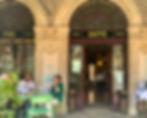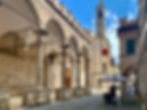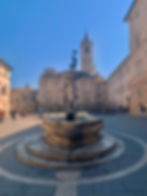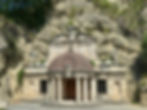Ascoli Piceno, the Travertine City
- Mike
- Aug 14
- 6 min read

The Piceni people in the centuries before Christ did not take kindly to Roman domination in their uneasy alliance that lasted for 200 years. The peace was finally shattered in 91 B.C. when the Ascolani slaughtered a delegation from Rome and embarked on a killing spree of other Romans resident in their town. Thus began the three year Social War between Rome and the Italic League, made up of various tribes in central Italy with their capital at Corfinium near present day Sulmona.

The inevitable Roman victory resulted in the destruction of Ascoli Piceno but with Roman occupation and peace came Roman rebuilding and from an empty canvas they built a marvelous city entirely of travertine. The Romans were already familiar with the advantages and beauty of this sedimentary form of quite pliable limestone and the abundance of travertine in local quarries made it the easiest material with which to rebuild Ascoli.

The travertine was put to use in solid blocks rather than as veneers or superficial inlays so when subsequent building took place in the Medieval and Renaissance periods the travertine was recycled by incorporating it into later structures. A good example of this is the magnificent Piazza del Popolo, possibly the most beautiful and elegant piazza in all of Italy.
Given its central location it may have been the site of the old Roman forum but it took on its present shape and design in the early Renaissance period when the square was paved with large slabs of travertine and its architectural dimensions of porticoes, loggias and travertine columns were established.

Caffè Meletti
The best vantage point from which to admire the Piazza del Popolo is without doubt the famous Caffè Meletti. For those familiar with the sweet anise liqueur meletti from le Marche, the name of the Caffè Meletti is no coincidence because the drink's inventor, Silvio Meletti, purchased the building in 1905 and after two years of work creating the Liberty style interior and neoclassical façade, the Caffè Meletti was officially opened in 1907.

The original ceiling frescoes were plastered over at this time but rediscovered when the building was restored in 1988 after being closed for several years.
Elena has a very personal connection to the Piazza del Popolo because her grandparents met in this square and her late father was born 90 years ago in a house just around the corner. Our visit to the Caffè Meletti nine years ago (above photo) was a nostalgic trip for her father to a place that his parents used to come for coffee not many years after it first opened in 1907.
On our most recent visit I was a little disappointed with Caffè Meletti because it has become a victim of its own fame and there were more people there simply to take photos rather than people dinking coffee. Seeing how absurdly expensive the coffee has become, clearly locals have been priced out of the establishment and it is now unfortunately mostly a destination for tourists.
Loggia dei Mercanti

At the opposite end of the piazza from Caffè Meletti is the Church of San Francesco with the Loggia dei Mercanti set in front of a part of the church. Located at the main Roman intersection of the Cardo and Decumanus thoroughfares, it was completed in 1514 as an exhibition area for the wool merchants to display their products and consists of 5 high arches made of travertine. On a travertine slab inset under the loggia are details inscribed in the 16th century of various measurements of the bricks used in the construction.

Behind the church in the open air cloisters (above photo) there is often a fruit and vegetable market but avoid the main Ascoli Piceno market mornings of Wednesday and Saturday if you want to appreciate Piazza del Popolo because on these days the entire square is filled with stalls and the piazza is totally hidden. Not sure why they allow the market to spoil this square twice a week because many visitors must go home disappointed if they have only one day here.
The recent Italian film 'The Shadow of the Day' was filmed entirely in the Piazza del Popolo with the interior of Caffè Meletti acting as the restaurant where most of the dramatic action takes place.

Piazza Arringo
It's not as visually dramatic as the Piazza del Popolo but it's bigger and in fact much older and has a better claim to be the original location of the Roman forum. Throughout the long history of Ascoli it was in Piazza Arringo that the citizen assemblies met after Ascoli became a self-governing municipality in the Middle Ages and the name of the piazza itself derives from the process of aggressively convincing people of your point of view and gave rise to the word 'harangue' in the English language.

The Palazzo dell’Arengo and the Cathedral of Sant’Emidio are both located in this piazza and it was here that the Ascolani gathered to listen to Saint Francis of Assisi in 1215. It was probably also in this square on February 10th 49 B.C. that Julius Caesar stayed after conquering Asculum (as Ascoli Piceno was known then) exactly one month after crossing the Rubicon and making his famous remark “Alea iacta est”. Not long afterwards he would enter Rome as the first Roman Emperor.

The Cathedral of Sant'Emidio is another example of the liberal use of travertine, much of it probably recycled during the various stages of construction that lasted hundreds of years until its completion in the 16th century.
The original structure where the 12th century Romanesque baptistry now stands was built over the remains of a pagan Roman temple using the remains of the civic basilica of the Roman forum according to archeological research.
Inside the baptistry today there are Roman remains from the period of Augustus as well as the baptismal font used by the first Christians between 400 and 500 A.D.
The Palazzo dell'Arrengo houses the Civic Art Gallery (Pinacoteca Civica) that fills 15 exhibition rooms with works of art that have been collected and donated over the last 160 years. Included among them is the cape worn by Pope Nicholas IV in the 13th century that disappeared for a couple of years and was subsequently bought at auction abroad before being returned by the unwitting buyer.
Tempietto di Sant’Emidio
Leaving the centro storico, crossing over the old Roman bridge Ponte di Solestà and then north across the main road there is a nondescript side road called Via Carso that leads you to the early 18th century Tempietto di Sant’Emidio (below photo).

A classic example of Baroque period religious art it has a travertine façade and is built into the tuff rock where ancient tunnels and and catacombs of the early Christians intersect with the interior portion of this small temple.
Local tradition tells of Saint Emidio walking here carrying his own head in his hands after being beheaded in 303 A.D near the Porta Solestà bridge. The remains of the saint rested here for 700 years until they were transferred to the crypt of the Cathedral bearing his name in Piazza Arringo.
The small temple in the rock here was created and paid for by the people of Ascoli in gratitude for having been spared the worst of the violent earthquakes that rocked l’Aquila in 1703.
Olive Ascolane

If you had to name one thing that Ascoli Piceno is known for in the rest of Italy it might well be the famous stuffed olives instead of the more deserving Piazza del Popolo. My mother-in-law learned how to make olive ascolane 60 years ago from her Ascolana mother-in-law and has made them every Christmas ever since, continuing even today at 89 years old. Having watched the process numerous times I can attest to the fact that it is probably the single most time consuming dish you can make in an Italian kitchen.